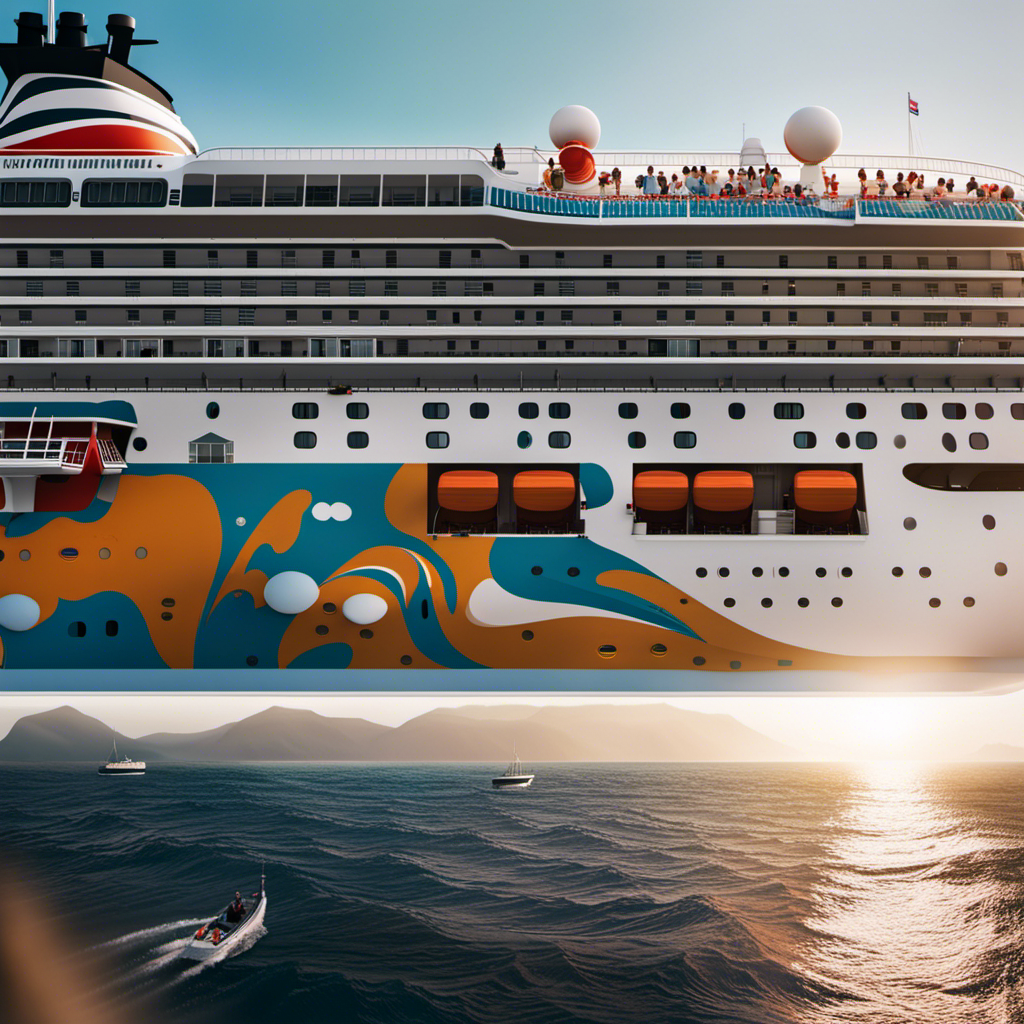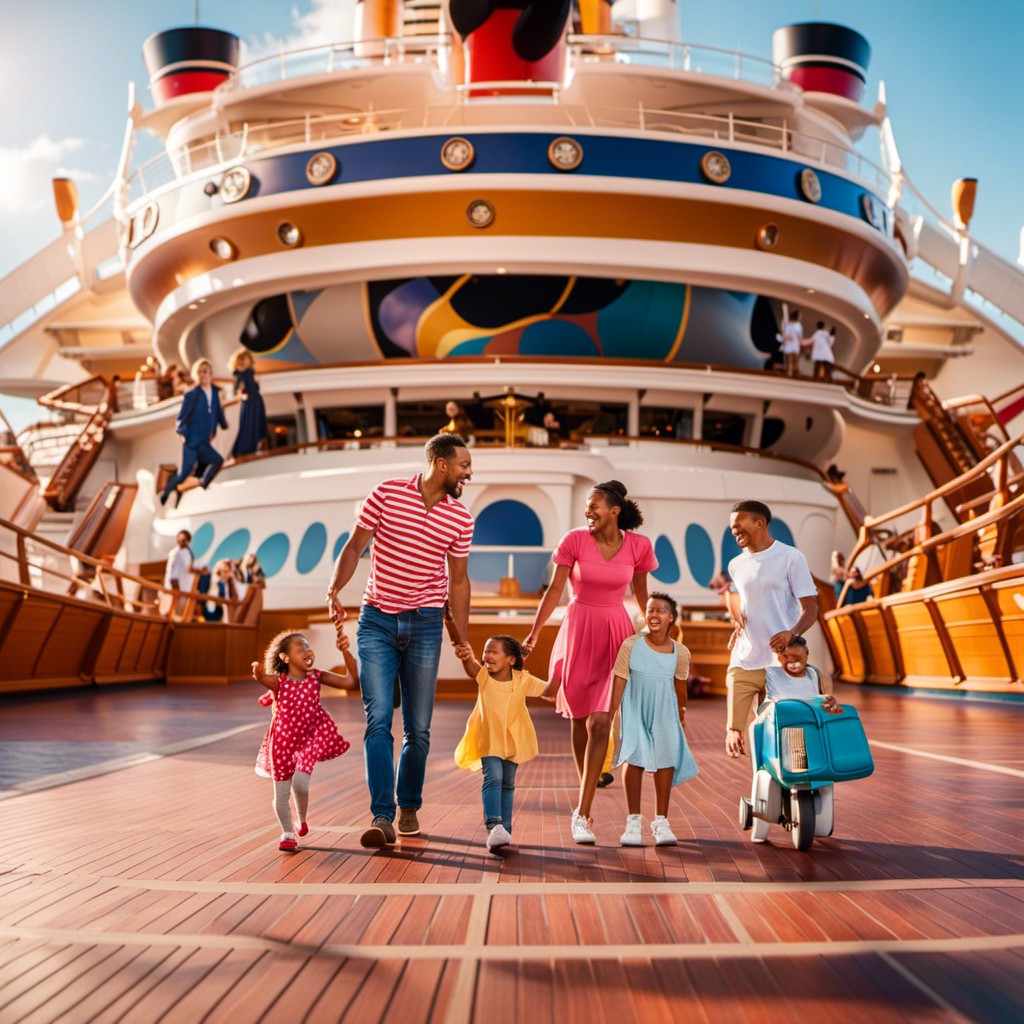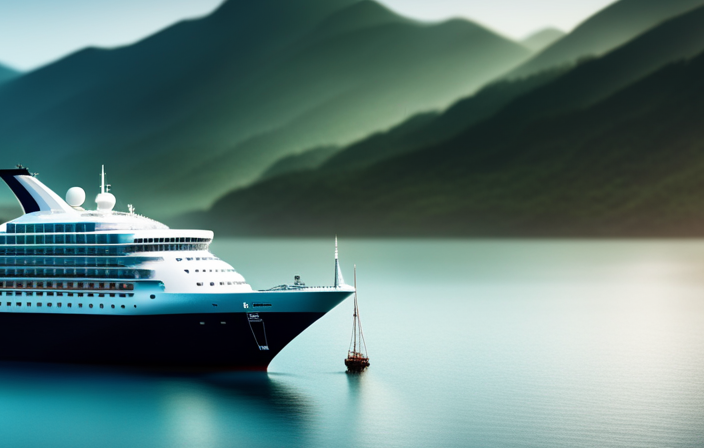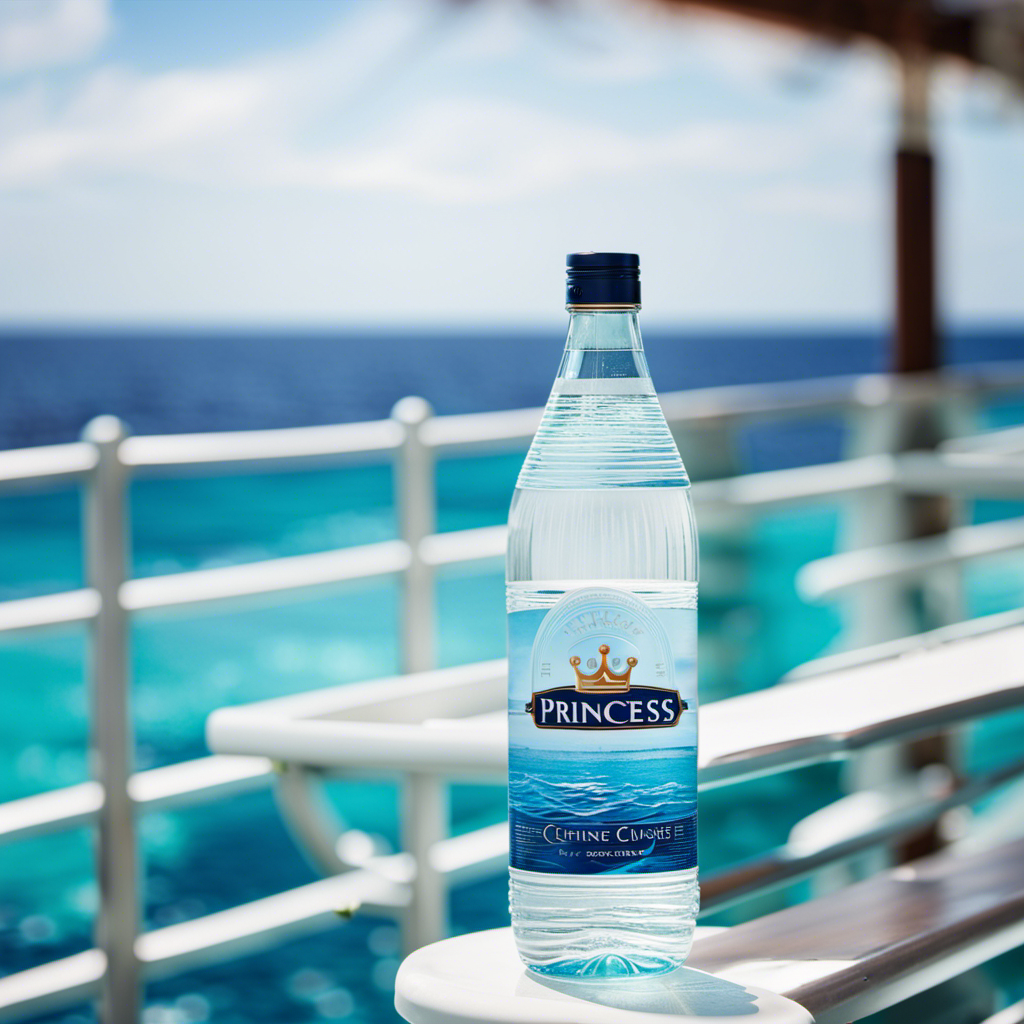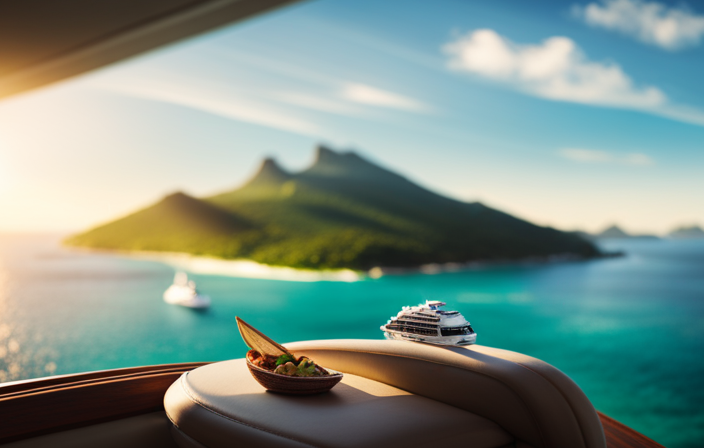Stepping aboard an immense cruise ship, I find myself astounded by its enormous capacity and the ability to house a multitude of guests. It’s like a floating city, providing both escapades and relaxation for countless voyagers.
In this article, we will delve into the intriguing world of cruise ship capacities. We will explore the historical perspective, factors influencing maximum capacity, and the innovative ways cruise lines determine ideal passenger numbers.
Join me on this journey as we uncover the fascinating intricacies of how many people a cruise ship can truly hold.
Key Takeaways
- Cruise ships have evolved over time, with advancements in technology and shipbuilding techniques allowing for larger capacities.
- The layout and amenities of a cruise ship, including the number and size of cabins, dining areas, lounges, and entertainment venues, determine its maximum capacity.
- Passenger safety is a critical factor in determining the maximum capacity, with considerations for adequate lifeboat capacity and emergency exits.
- The size and design of a cruise ship, as well as the number of cabins and average occupancy per cabin, play a significant role in determining its maximum passenger capacity.
Historical Perspective on Cruise Ship Capacities
In the past, cruise ships couldn’t hold as many people as they do now. Ship size and passenger demand have been two key factors influencing the maximum capacity of cruise ships throughout history.
As technology and shipbuilding techniques advanced, ships were able to accommodate more passengers. In the early days of cruising, ships were relatively small and had limited space for guests. However, as the popularity of cruising grew, so did the size of the ships. Demand from passengers wanting to experience the luxury and excitement of a cruise vacation led to the construction of larger and more spacious vessels.
Today, cruise ships can hold thousands of passengers, with some of the largest ships reaching capacities of over 6,000 guests. This increase in capacity has allowed the cruise industry to cater to a wider range of travelers and offer a variety of amenities and activities onboard.
Moving forward, it will be interesting to see how shipbuilders continue to innovate and meet the ever-growing demand for larger and more extravagant cruise ships.
Factors Influencing the Maximum Capacity of Cruise Ships
Factors like the layout and amenities determine how much a cruise ship can accommodate. When determining the ideal capacity of a cruise ship, various factors must be taken into consideration.
The layout of the ship plays a crucial role in determining how many passengers can be accommodated comfortably and safely. The number and size of cabins, as well as the availability of public spaces such as dining areas, lounges, and entertainment venues, all contribute to the ship’s overall capacity.
Passenger safety is of utmost importance in determining the maximum number of passengers a ship can hold. Adequate lifeboat capacity, evacuation procedures, and emergency exits are essential for ensuring the safety of all passengers on board. These factors must be carefully assessed to ensure that the ship can comfortably and safely accommodate the desired number of passengers.
As we move on to discuss the largest cruise ships in the world by passenger capacity, it is important to note that these factors play a critical role in determining the maximum capacity of these ships.
Largest Cruise Ships in the World by Passenger Capacity
When it comes to cruise ships, one of the most important factors to consider is the maximum passenger capacity. This determines how many people can be accommodated on board, and it plays a significant role in the overall experience of the passengers.
In addition to the passenger capacity, the popularity of a cruise ship is also a key consideration, as it reflects the demand and appeal of the ship among travelers.
Maximum Passenger Capacity?
The maximum passenger capacity of a cruise ship depends on various factors like the size and design of the vessel. To analyze the maximum capacity of a cruise ship, one must consider the number of cabins available, the average occupancy per cabin, and the availability of additional beds such as pull-out sofas or bunk beds.
The layout of the ship also plays a crucial role in determining its maximum capacity. Public areas like restaurants, theaters, and lounges need to be spacious enough to accommodate a large number of passengers comfortably. Additionally, safety regulations and lifeboat capacity must be taken into account to ensure the well-being of all passengers.
The maximum capacity of a cruise ship has a significant impact on the overall customer experience, as overcrowding can lead to longer lines, limited seating, and a less enjoyable vacation. So, when choosing a popular cruise ship, it’s essential to consider its maximum passenger capacity to ensure a comfortable and enjoyable experience for everyone on board.
Popular Cruise Ship?
A popular cruise ship can comfortably accommodate a large number of passengers. With its state-of-the-art amenities and luxurious accommodations, it is no wonder why this cruise ship is a top choice for travelers worldwide.
Here are some of the cruise ship amenities that make it so popular:
- Spacious and well-appointed cabins with stunning ocean views
- Multiple dining options offering a wide range of cuisines
- Onboard entertainment such as live shows, concerts, and casinos
- Relaxing spa and wellness facilities for ultimate pampering
- Exciting activities like water slides, rock climbing walls, and sports courts
These amenities ensure that passengers have a memorable and enjoyable experience throughout their journey.
Now, let’s explore the impact of size on a cruise ship, as it plays a crucial role in determining its maximum passenger capacity.
Impact of Size?
To truly understand the impact of size on a cruise ship, picture yourself navigating through narrow waterways and docking in smaller ports with ease. The size of a cruise ship has a significant influence on its ability to access certain destinations and maneuver through various water channels.
Additionally, ship size impacts the overall passenger to crew ratio, which plays a crucial role in providing an exceptional level of service to guests on board. Cruise lines carefully analyze the passenger to crew ratio to ensure that there are enough crew members to attend to the needs of each passenger effectively. This analysis helps determine the ideal passenger capacity for a cruise ship, balancing the number of passengers with the available crew members.
How Cruise Lines Determine the Ideal Passenger Capacity
Did you know that cruise lines determine the ideal passenger capacity based on factors like safety regulations and customer comfort?
When it comes to cruise line profitability, it is essential to strike a balance between maximizing the number of passengers onboard and ensuring their comfort and safety. To achieve this, cruise lines carefully consider various factors such as the ship’s size, layout, and amenities. By analyzing these elements, cruise lines can determine the optimal number of passengers that can be comfortably accommodated onboard.
They also take into account safety regulations, which specify the maximum number of passengers allowed on a ship based on its size and facilities. Ultimately, the goal is to provide an enjoyable experience for passengers while ensuring their safety.
Now, let’s explore the impact of ship size on passenger capacity…
The Impact of Ship Size on Passenger Capacity
One key factor in determining the ideal passenger capacity is the size of the ship. Ship size has a significant impact on the overall capacity of a cruise ship. Larger ships are able to accommodate more passengers due to their increased space and facilities. They often have multiple decks and a larger number of cabins, allowing for a higher passenger capacity. Additionally, larger ships can offer a wider range of amenities such as restaurants, theaters, and recreational areas, which attract more passengers.
On the other hand, smaller ships have a more limited capacity due to their size constraints. They may have fewer cabins and fewer amenities, resulting in a lower passenger capacity. Therefore, ship size is a crucial determinant when it comes to estimating the number of passengers a cruise ship can accommodate.
Understanding the passenger-to-crew ratio on cruise ships is another important aspect to consider.
Understanding the Passenger-to-Crew Ratio on Cruise Ships
Understanding the passenger-to-crew ratio on cruise ships can greatly impact your overall experience onboard. Crew management plays a crucial role in ensuring passenger satisfaction. With more crew members available, there is a higher likelihood of prompt service and attention to detail. This ratio is carefully calculated to maintain a high level of service throughout the ship.
A well-managed crew ensures that passengers’ needs are met efficiently, contributing to a positive cruise experience. However, overcrowding concerns and safety measures on cruise ships must also be taken into account. It is important to strike a balance between maximizing passenger capacity and ensuring the safety and comfort of everyone onboard.
Overcrowding Concerns and Safety Measures on Cruise Ships
When it comes to overcrowding concerns on cruise ships, safety protocols play a crucial role in ensuring the well-being of passengers.
From implementing passenger capacity regulations to managing emergency evacuations, cruise lines have a responsibility to prioritize the safety of their guests.
Safety Protocols for Overcrowding
To ensure the safety of all passengers, it is important to be aware of the established protocols for overcrowding on a cruise ship. Overcrowding prevention is a crucial aspect of passenger safety measures in the cruise industry. Cruise lines have implemented various strategies to address this concern.
Firstly, they closely monitor the number of passengers on board and strictly adhere to the ship’s maximum capacity. This ensures that the ship does not exceed its safe occupancy limit. Additionally, cruise ships have designated muster stations and evacuation plans in place to efficiently evacuate passengers in case of an emergency.
Crew members are trained extensively on crowd management techniques to maintain order and ensure the safety of all passengers during peak times, such as embarkation and disembarkation. By following these protocols, cruise lines prioritize the safety and well-being of their passengers.
Now let’s delve into the passenger capacity regulations.
Passenger Capacity Regulations
Make sure you’re familiar with the passenger capacity regulations on a cruise ship and follow them closely for the safety of everyone on board. These regulations are in place to ensure that the ship can safely accommodate all passengers and crew members.
The passenger capacity of a cruise ship is determined by its size and layout. Larger ships generally have a higher passenger capacity, as they have more space to accommodate amenities and cabins. However, it’s important to note that the impact of ship size goes beyond just the number of passengers.
Larger ships may require additional safety measures and resources to manage emergency situations. This includes having enough lifeboats and evacuation procedures in place to safely evacuate all passengers in case of an emergency.
Managing Emergency Evacuations
It’s crucial to have effective emergency evacuation procedures in place on a cruise ship to ensure the safety of all passengers and crew members. In managing logistics for emergency response, there are several key considerations:
-
Clear communication channels: Establishing efficient communication systems between crew members and passengers is vital during an emergency.
-
Training and drills: Regular training sessions and evacuation drills help familiarize everyone with the procedures, reducing panic and ensuring a swift response.
-
Well-defined evacuation routes: Planning and mapping out clear evacuation routes throughout the ship is essential for a smooth evacuation process.
By effectively managing these logistics, cruise ships can ensure a coordinated and efficient response in case of emergencies.
Moving forward, let’s explore the role of amenities and public spaces in ship capacity without compromising safety.
The Role of Amenities and Public Spaces in Ship Capacity
The role of amenities and public spaces greatly affects a cruise ship’s capacity. The amenities impact the number of passengers a ship can accommodate, as well as the overall experience they have on board. Public spaces, such as lounges, restaurants, and entertainment venues, influence the flow of passengers and the ability for the ship to handle a large number of people comfortably.
To illustrate this, let’s take a look at a comparison table:
| Amenities | Impact on Capacity |
|---|---|
| Spacious cabins | Higher capacity |
| Multiple dining options | Higher capacity |
| Onboard activities | Higher capacity |
| Fitness facilities | Higher capacity |
| Entertainment venues | Higher capacity |
As you can see, the presence of these amenities enhances a cruise ship’s capacity by attracting more passengers and providing them with a variety of options for relaxation and entertainment. This, in turn, affects the overall design and layout of the ship to ensure optimal passenger capacity without compromising comfort and safety.
Cruise Ship Design and Layout for Optimal Passenger Capacity
In order to maximize passenger capacity on a cruise ship, careful consideration must be given to the design and layout of the vessel. Cruise ship space optimization is a key factor in achieving this goal.
By strategically planning the placement of amenities and public spaces, cruise lines can ensure that passengers have access to the necessary facilities while still maintaining a comfortable and enjoyable experience. This involves finding the right balance between providing enough space for passengers to move around freely and making efficient use of every available inch.
From the arrangement of cabins to the placement of entertainment venues and dining areas, every aspect of the ship’s design is meticulously planned to optimize capacity without compromising passenger comfort and experience.
As the demand for cruise vacations continues to grow, cruise lines are constantly innovating and exploring new ways to enhance their ships’ capacities and offerings.
Future Trends in Cruise Ship Capacities and Innovations
As cruise vacations continue to grow in popularity, cruise lines are constantly exploring new ways to enhance their ships’ capacities and offerings. The future of cruise ship capacities holds exciting possibilities as technological advancements and innovative designs come into play.
Cruise lines are investing in state-of-the-art engineering to increase the number of passengers they can accommodate. They are exploring the use of advanced propulsion systems, such as LNG-powered engines, which not only reduce emissions but also free up more space for additional cabins and amenities.
Moreover, cruise companies are developing new technologies to optimize onboard space utilization, such as vertical cabins and rotating decks. These future innovations will not only allow cruise ships to accommodate more passengers but also provide enhanced experiences and amenities, ensuring that cruise vacations continue to be a popular choice for travelers.
Frequently Asked Questions
How Does the Passenger-To-Crew Ratio Affect the Overall Experience on a Cruise Ship?
The passenger-to-crew ratio greatly impacts the overall experience on a cruise ship. A higher ratio can lead to decreased passenger satisfaction and longer wait times, while a lower ratio can result in improved crew efficiency and a more personalized experience.
What Safety Measures Are Put in Place to Prevent Overcrowding on Cruise Ships?
Safety measures on cruise ships include implementing passenger capacity limits, monitoring crowd sizes, and utilizing advanced technology for tracking and managing passenger movement. These measures ensure cruise ship overcrowding prevention and prioritize passenger safety.
How Do Cruise Lines Determine the Ideal Passenger Capacity for a Ship?
When determining the ideal passenger capacity for a cruise ship, cruise lines consider various factors such as safety regulations, available space, and amenities. Calculations are made based on these factors to ensure optimal occupancy.
What Role Do Amenities and Public Spaces Play in Determining the Capacity of a Cruise Ship?
A cruise ship’s amenities and public spaces are like puzzle pieces that determine its capacity. The design and technology of these areas, along with the impact of entertainment options, all play a crucial role in maximizing the number of passengers it can hold.
What Are Some Future Trends and Innovations in Cruise Ship Capacities?
Future trends and innovations in cruise ship capacities include the development of larger and more technologically advanced ships, such as the use of AI and virtual reality. These advancements aim to enhance the overall guest experience and accommodate a larger number of passengers.
Conclusion
In conclusion, the capacity of cruise ships is a fascinating and ever-evolving topic.
From historical perspectives to future trends, it is clear that factors such as ship size, amenities, and safety measures play a crucial role in determining passenger capacity.
The largest cruise ships in the world showcase the industry’s commitment to providing an unforgettable experience for millions of people.
As innovations continue to shape the future, cruise ship capacities are set to soar, satisfying the wanderlust of wanderers worldwide.
Alfons is the visionary leader and driving force behind Voyager Info’s success. As the Editor in Chief, he brings a wealth of experience and an unwavering passion for travel to the helm of our cruise-centric platform.
With a lifelong fascination for exploring new horizons, Alfons discovered his love for the ocean and cruising at a young age. From sailing across pristine Caribbean waters to embarking on daring expeditions to far-flung destinations, he has amassed a treasure trove of first-hand experiences in the world of cruising.

